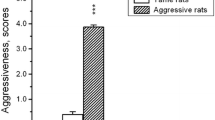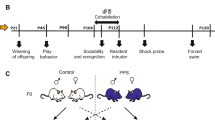Abstract
The effect of the maternal environment on intermale aggression was studied by means of embryo transfer of genetically selected aggressive (SAL) and nonaggressive wild house mice (LAL), and their reciprocal F1's, to standard (NMRI) females. No effect was found on the attack latency scores (ALS), i.e., aggression: all genotypes born and raised under natural conditions showed an ALS similar that of genotypes born and raised by NMRI females. Since previous studies on wild house mice failed to demonstrate postnatal effects on aggression, and the present results indicate the absence of prenatal maternal environmental effects on aggression, the primacy of genetic over maternal variance in the development of adult intermale aggression in wild house mice is indicated.
Similar content being viewed by others
References
Barlow, D. P. (1995). Gametic imprinting in mammals.Science 270:1610–1613.
Benus, R. F., Bohus, B., Koolhaas, J. M., and van Oortmerssen, G. A. (1991). Heritable variation for aggression as a reflection of individual coping strategies.Experientia 47:1008–1019.
Bohus, B., Benus, R. F., Fokkema, D. S., Koolhaas, J. M., Nyakas, C., van Oortmerssen, G. A., Prins, A. J. A., de Ruiter, A. J. H., Scheurink, A. J. W., and Steffens, A. B. (1987). Neuroendocrine states and behavioral physiological stress responses. In De Kloet, E. R., Wiegant, V. M., and de Wied, D. (eds.),Progress in Brain Research, Vol. 72, Elsevier, Amsterdam, pp. 57–70.
Burgoyne, P. (1993). A Y chromosomal effect on blastocyst cell number in mice.Development 117:341–345.
Carlier, M., Roubertoux, P. L., and Pastoret, C. (1991). The Y chromosome effect on intermale aggression in mice depends on the maternal environment.Genetics 129:231–236.
Carlier, M., Nosten-Bertrand, M., and Michard-Vanhée, C. (1992). Separating genetic effects from maternal environmental effects. In Goldowitz, D., Wahlsten, D., and Wimer, R. (eds.),Techniques for the Genetic Analysis of Brain and Behavior: Focus on the Mouse. Techniques in the Behavioral and Neural Sciences, Vol. 8., Elsevier, Amsterdam, pp. 111–126.
Catlett, R. H. (1961). An evaluation of methods for measuring fighting behaviour with special reference toMus musculus.Anim. Behav. 9:8–10.
Crowcroft, P. (1966).Mice All Over, Foulis, London.
Denenberg, V. H., Gaulin-Kremer, E., Gandelman, R., and Zarrow, M. X. (1973). The development of standard stimulus animals for mouse (Mus musculus) aggression testing by means of olfactory bulbectomy.Anim. Behav. 21:590–598.
Eleftheriou, B. E., Bailey, D. W., and Denenberg, V. H. (1974). Genetic analysis of fighting behavior in mice.Physiol. Behav. 13:773–777.
Hahn, M. E., and Haber, S. B. (1982). The inheritance of agonistic behavior in male mice: A diallel analysis.Aggress. Behav. 8:19–38.
Maxson, S. C. (1992). Methodological issues in genetic analyses of an agonistic behavior (offense) in male mice. In Goldowitz, D., Wahlsten, D., and Wimer, R. (eds.),Techniques for the Genetic Analysis of Brain and Behavior: Focus on the Mouse. Techniques in the Behavioral and Neural Sciences, Vol. 8, Elsevier, Amsterdam, pp. 349–373.
Ressler, R. H. (1962). Parental handling in two strains of mice reared by foster parents.Science 137:129–130.
Roubertoux, P. L., and Carlier, M. (1988). Differences between CBA/H and NZB mice on intermale aggression. II. Maternal effects.Behav. Genet. 18:175–184.
Roubertoux, P. L., Nosten-Bertrand, M., and Carlier, M. (1990). Additive and interactive effects of genotype and maternal environment.Adv. Study Behav. 19:205–247.
Roubertoux, P. L., Carlier, M., Degrelle, H., Haas-Dupertuis, M.-C., Phillips, J., and Moutier, R. (1994). Co-segregation of intermale aggression with the pseudoautosomal region of the Y chromosome in mice.Genetics 135:225–230.
Sluyter, F., van Oortmerssen, G. A., and Koolhaas, J. M. (1994). Studies on wild house mice. VI. Differential effects of the Y chromosome on intermale aggression.Aggress. Behav. 20:379–386.
Sluyter, F., Bult, A., Lynch, C. B., van Oortmerssen, G. A., and Koolhaas, J. M. (1995a). A comparison between house mouse lines selected for attack latency or nest-building: Evidence for a genetic basis of alternative behavioral strategies.Behav. Genet. 25:247–252.
Sluyter, F., Meijeringh, B. J., van Oortmerssen, G. A., and Koolhaas, J. M. (1995b). Studies on wild house mice. VIII. Postnatal maternal influence on intermale aggression in reciprocal F1's.Behav. Genet. 25:367–370.
Sluyter, F., Korte, S. M., Bohus, B., and van Oortmerssen, G. A. (1996). Behavioral stress response of genetically selected aggressive and non-aggressive wild house mice in the shock-probe/defensive burying test.Pharm. Biochem. Behav. 54:113–116.
Thung, P. J., Boot, L. M., and Muhlbock, O. (1956). Senile changes in oestrus cycle and in ovarian structure in some inbred strains.Acta Endocrinol. 23:8–32.
van der Hoeven, F. A., Schouten, M., and de Boer, P. (1991). Embryo survival in pseudopregnant and in pregnant but genetically semi-sterile recipients after nonsurgical embryo transfer in the mouse.Theriogenology 36:463–475.
van Oortmerssen, G. A., and Bakker, T. C. M. (1981). Artificial selection for short and long attack latencies in wild Mus musculus domesticus.Behav. Genet. 11:115–126.
van Oortmerssen, G. A., Benus, R. F., and Dijk, D. J. (1985). Studies in wild house mice: Genotype-environment interactions for attack latency.Neth. J. Zool. 35:155–169.
van Oortmerssen, G. A., Benus, R. F., and Sluyter, F. (1992). Studies on wild house mice. IV. On the heridity of testosterone and readiness to attack.Aggress. Behav. 18:143–148.
van Zegeren, K. (1980). Variation in aggressiveness and the regulation of numbers in house mouse populations.Neth. J. Zool. 30:635–770.
Wahlsten, D., and Wainwright, P. (1977). Application of a morphological time scale to hereditary differences in prenatal mouse development.J. Embryol. Exp. Morphol. 42:79–92.
Walker, S. K., Heard, T. M., and Seamark, R. F. (1992). In vitro culture of sheep embryos without co-culture: Successes and perspectives.Theriogenology 37:111–126.
Author information
Authors and Affiliations
Corresponding author
Rights and permissions
About this article
Cite this article
Sluyter, F., van der Vlugt, J.J., van Oortmerssen, G.A. et al. Studies on wild house mice. VII. Prenatal maternal environment and aggression. Behav Genet 26, 513–518 (1996). https://doi.org/10.1007/BF02359756
Received:
Accepted:
Issue Date:
DOI: https://doi.org/10.1007/BF02359756




